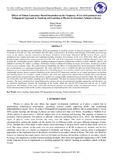Effects of Virtual Laboratory-Based Instruction on the Frequency of Use of Experiment as a Pedagogical Approach in Teaching and Learning of Physics in Secondary Schools in Keny

View/
Date
2023-11-15Author
Okono, Elijah
Wangila, Eric
Chebet, Annet
Metadata
Show full item recordAbstract
Information and communications technology (ICT) incorporation in teaching physics in Kenyan secondary schools cannot be overlooked, given the key roles and benefits that ICT offers in the process of teaching and learning. Consistently poor average scores in the subject currently witnessed at the Kenya Certificate of Secondary Education (KCSE) level in Physics can be attributed to low student motivation and traditional teaching strategies. For instance, in the years 2016, 2017, 2018, and 2019, Kisumu County registered low mean scores of 4.23, 4.98, 4.67, and 4.10, respectively, in physics in KCSE. Therefore, there is a need for the incorporation of more effective teaching strategies to improve performance in physics and for students’ interest and attitude in learning the subject to change. Technology-based or enhanced learning leverages all learners, irrespective of their traits or socio-economic status. This study aimed at establishing the effects of virtual laboratory-based instruction (VLBI) on the use of experiments as a pedagogical approach. The study objectives were to establish the effect of virtual laboratories on the frequency of use of experimental teaching approaches in learning physics in secondary schools and to determine the extent of the relationship between physics teachers knowledge of the selected ICT frameworks and the use of virtual experiments in teaching and learning physics in secondary schools in Kenya. The study was supported by behaviourism learning theory and adopted quasi-experimental research designs. The physics teachers were purposefully sampled from each selected school. The sample size was 44 teachers and 358 students, summing up to 402 respondents. The data was analyzed using both descriptive and inferential statistics. The study concluded that virtual laboratories advance the use of experimental teaching approaches and that there was no statistical significance between the knowledge of the teacher about the selected ICT framework and the use of virtual experiments. The findings of this study would help educational planners successfully design and implement various classroom-based innovations that would enable seamless integration of virtual laboratories into classroom instruction.
URI
https://doi.org/10.51867/ajernet.4.2.116https://ajernet.net/ojs/index.php/ajernet/article/view/164
http://ir-library.mmust.ac.ke:8080/xmlui/handle/123456789/2431
Collections
- Gold Collection [1026]
